France
About Andrew Cusack
 Writer, web designer, etc.; born in New York; educated in Argentina, Scotland, and South Africa; now based in London.
Writer, web designer, etc.; born in New York; educated in Argentina, Scotland, and South Africa; now based in London. read more
News
Blogs
Reviews & Periodicals
Arts & Design
World
France
Mitteleuropa
Knickerbockers
Argentina
The Levant
Africa
Cape of Good Hope
Netherlands
Scandinavia
Québec
India
Muscovy
Germany
Academica
Fête Chiracienne
AS TODAY IS the eighty-fourth birthday of Monsieur Jacques René Chirac, I thought it’d be best to share a few images of the underappreciated fifth president of the Fifth Republic (not to mention sometime Mayor of Paris, Prime Minister of France, and Co-Prince of Andorra) doing the things he does best. (more…)
The Anthropophagus Has Quitted His Den
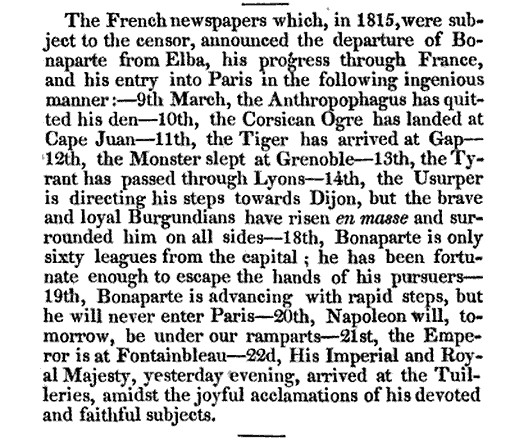
The Museum of Foreign Literature Science and Arts was a Philadelphia periodical edited by the prodiguously talented and unjustly neglected Eliakim Littell.
In January 1831 his review published this little snippet of headlines claimed to have been clipped from French newspapers:
The French newspapers which, in 1815, were subject to the censor, announced the departure of Bonaparte from Elba, his progress through France, and his entry into Paris in the following ingenious manner:
March 9 THE ANTHROPOPHAGUS HAS QUITTED HIS DEN
March 10
THE CORSICAN OGRE HAS LANDED AT CAPE JUAN
March 11
THE TIGER HAS ARRIVED AT GAP
March 12
THE MONSTER SLEPT AT GRENOBLE
March 13
THE TYRANT HAS PASSED THOUGH LYONS
March 14
THE USURPER IS DIRECTING HIS STEPS TOWARDS DIJON
but the brave and loyal Burgundians have risen en masse
and surrounded him on all sidesMarch 18
BONAPARTE IS ONLY SIXTY LEAGUES FROM THE CAPITAL
He has been fortunate enough to escape the hands of his pursuersMarch 19
BONAPARTE IS ADVANCING WITH RAPID STEPS
But he will never enter ParisMarch 20
NAPOLEON WILL, TOMORROW, BE UNDER OUR RAMPARTS
March 21
THE EMPEROR IS AT FONTAINEBLEAU
March 22
HIS IMPERIAL & ROYAL MAJESTY, yesterday evening, arrived at the Tuileries, amidst the joyful acclamation of his devoted and faithful subjects.
Voltaire’s Works Are Not Dead
They Are Alive: And They Are Killing Us
“It was a little after nine in the evening; the sun was setting, the weather superb. … Nothing is rare, nothing is more enchanting than a beautiful summer evening in St Petersburg. Whether the length of the winter and the rarity of these nights, which gives them a particular charm, renders them more desirable, or whether they really are so, as I believe, they are softer and calmer than evenings in more pleasant climates.”
The Soirées Saint-Petersbourg of Joseph de Maistre are philosophical dialogues that sometimes border on the mystical and delve into the dark recesses of human nature. They are eloquent, fascinating, and beautiful, traversing a broad range of subjects while hovering around evil and why it exists in the world.
In this extract from the Fourth Dialogue, the Count — generally taken to represent the author’s own view — objects to the young Chevalier citing Voltaire approvingly.
A critic might call it a rant; if so, it is at least a beautiful one:
The Epiphany 6 January 2016

Architectural historian Gavin Stamp argues that if Rhodes really was such a vicious baddie as his opponents claim, why stop with just removing his statue?
South African academic and Rhodes scholar R. W. Johnson has compared the campaign to remove Rhodes statues to ISIL’s destruction of antiquities in the Middle East while clerical commentator Fr Alexander Lucie-Smith recalls the damnatio memoriae.
Most interesting perhaps is the treatment of Rhodes not in the ivory towers of Oxford or Cape Town but in the land that once bore his name. Rhodes’s grave still lies in a prominent spot in the Motopos, but even President Robert Mugabe is against exhuming him.
From the Telegraph:
The last time that a call was made for the grave in the Matopos to be exhumed, Middleton Nyoni, then Town Clerk of Bulawayo, offered a telling response. “It is the Taliban who destroy history – and I am not a Taliban,” he declared. “After Rhodes’s grave, who is next?”
When Rhodesia became Zimbabwe in 1980, the city fathers of Bulawayo shifted Rhodes’s statue from the town centre to the town museum, while covering up the plaque commemorating his indaba with the chiefs of the Matabele. But in 2010 the city council voted to uncover the plaque while last year the Zimbabwean playwright Cont Mhlanga provocatively suggested returning Bulawayo’s statue of Rhodes to its former place of prominence.
U.C.T. has dumped Rhodes – though he remains elsewhere on Table Mountain – and his statue is still at Oriel… for now.
– This time last year, Pascal-Emmanuel Gobry asked if the Christian revival was starting in France. My pilgrimage to Chartres provided me with evidence that the faith across the Channel is deep, strong, and growing.
Now, looking forward to the year ahead, P.E.G. notes that Catholic France used to be old and rural — now it is young and urban: “In the major cities, all the churches are full on Sunday morning, something unthinkable even 10 years ago.”
– Former CIA agent Philip Giraldi visits Russia for the first time.
— All across the world, evidence shows that poverty is dropping dramatically. Why then, Fraser Nelson asks, is it so hard to believe?
Bicycle polo at the Wellington Monument in the Phoenix Park, 1938.
Chartres 2015
Chartres is filed in my mind as the cathedral of my childhood. I must’ve been around 4 or 5 when I first walked amidst this medieval vision of stone and stained glass — some years before I ever visited the cathedral of New York where I was born. Cathedrals offer a prodigious mental stomping ground for the imagination of a young boy, and David Macaulay’s pen-and-ink book Cathedral (winner of the 1975 Deutscher Jugendliteraturpreis — take note!) I read and re-read over and over again as a child.
The marvel of this great church is that, while most medieval cathedrals took centuries to build, Chartres was constructed in an astonishing fifty-four years between 1194 and 1250, lending it a unity as an architectural composition that puts its rivals to shame. Chartres was made a diocese as early as the third century and tradition even upholds that from around the year 50 B.C., local Druids who had heard the prophecies of Isaiah here enshrined a statue of the ‘Virgo Paritura’, the Virgin-who-will-give-birth.
Having such a long history, Chartres’ fortunes have waxed and waned. In medieval times it was one of the most popular pilgrimage shrines in all of Europe, and in the 11th and 12th century its cathedral school far outshone England’s provincial attempt at a university at Oxford. But France’s civil wars and then revolution put an end to the town’s days as a destination for pilgrims until the poet Charles Péguy revived them himself in the years leading up to the First World War.
For the past thirty-three years, the largest pilgrimage to Chartres has been undertaken over Pentecost weekend, a bank holiday in France which happily coincided with our second May bank holiday in Great Britain this year. On this trek, over 11,000 pilgrims walk all the way from Notre Dame de Paris to Notre Dame de Chartres. Our chapter of about twenty pilgrims marched under the banner of Notre Dame de Philerme, patroness of the Order of Malta — mostly French and British but with a few participants from other countries as well. (more…)
Faith, Freedom, and Respect
Religion grows in the very depths of our being. Mocking it, ridiculing it, can be especially hurtful.
by FRANÇOIS HUGUENIN
Unanimous France has marched on January 11 in the name of Charlie to defend freedom of expression. Is it useful to say at the start that, at this moment of national unity, I agree with the condemnation of these heinous acts of terrorism and that I welcome hearing some courageous voices dare to finally name the danger — radical Islamism? But I am surprised and worried to see a France that, with the resultant “diversity” noticeable in its absence, is becoming a supporter of a newspaper that it never bothered to read. The defence of freedom of expression seems to have created an epidemic of blindness with respect to the problems, not of the freedom to express ideas, but of the manner in which that freedom is used.
It is clear that freedom of expression is regulated in France, since some words (such as those inciting racial hatred) are legitimately subject to prosecution, while there are no laws against blasphemy. But the question posed by the humour of Charlie Hebdo, that everyone will enjoy according to their own standards, seems to be beyond the law. If liberty is a core value of our society, conquered after many struggles, is it assigned an absolute value that is greater than all the others? Doesn’t the motto of our republic put it at the same level of equality and fraternity? In the name of fraternity, we can not take seriously a value that is unlikely to be framed in legal texts, as it is impossible to codify, and yet is inherent in the dignity of man and entered in the heart of everyone: that of respect for others. This is precisely what makes a large contribution to the charm of life: giving up one’s seat on the bus to let an elderly person sit; politely asking your neighbour to lower the volume of his music instead of yelling in the stairway “Turn it down!” — none of this is prescribed by law, but it makes life better.
Now, if there is a value to be respected in others, it is his religion. (more…)
Evolution of a Napoleonic Parliament
The Salle des états in the Palais du Louvre
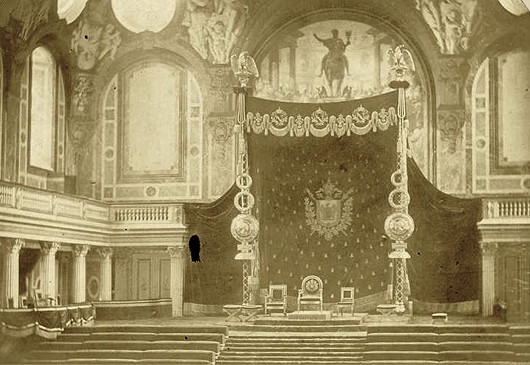
Among the numerous rituals of the ordinary visitor’s pilgrimage to Paris — trip up the Eiffel Tower, lunch at a tourist-trap café — braving the teeming hordes in the Louvre to view da Vinci’s ‘Mona Lisa’ ranks near the top. What very few of the camera-toting hordes realise is that they are shuffling through the room that once housed France’s parliament. The history of the Palais du Louvre is long, exceptional, and varied.
Originally built as a stern castle in the 1190s, the Louvre’s secure reputation led Louis IX to house the royal treasury there from the mid-thirteenth century. Charles V enlarged it in the fifteenth century to become a royal residence, while François Ier brought the grandeur of the Renaissance to the Louvre — as well as acquiring ‘La Gioconda’. In 1793, amidst the revolutionary tumult, part of the palace was opened to the public as the Musée du Louvre, but the Louvre has always housed a variety of institutions — the Ministry of Finance didn’t move out until 1983.
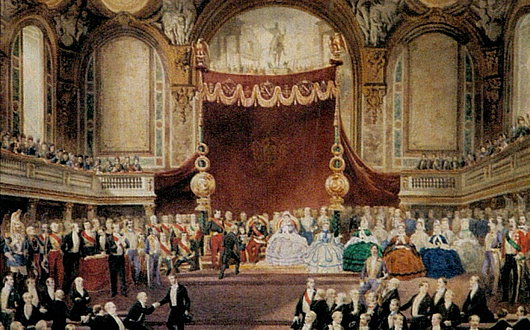
Napoleon III took as his official residence the Tuileries Palace which the Louvre was slowly enlarged towards over the centuries to incorporate. The Emperor needed a parliament chamber close at hand so he could easily address joint sittings of the Senate and the Corps législatif (as the lower house was called during the Second Empire) which opened the parliamentary year. By doing so at his residence, the Bonaparte emperor was following the example left by his kingly Bourbon predecessor Louis XVIII. (more…)
Two Flags Based on the French Tricolour
The French tricolour is one of the most influential flags in history, inspiring most prominently perhaps the Italian and Irish flags, but also dozens other, including the nationalist triband flags (like those of Germany, Russia, etc.). Indeed, the national flags of nearly sixty UN member states are based on these vertical or horizontal stripe combinations.
While long identified with revolution, republicanism, and nationalism, the French flag originally represented a combination of the blue and red of Paris — the colours of Saint Martin and Saint Denis — with the white of the French monarchy. Two (non-national) flags based directly on the French tricolour are those of the Acadians in North America and of Franschhoek in South Africa. (more…)
‘Bon Voyage’
Jean-Paul Rappeneau’s ‘Bon Voyage’ (2003) is one of those superb films that come around all too rarely. It manages to balance perfectly all the elements of drama, comedy, action, and romance, set in a convincing historical context.
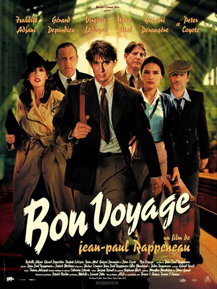
Bon Voyage
Jean-Paul Rappeneau
2003, France
1 hour 54 minutes
In 1940, Viviane Denvert (played by Isabelle Adjani) is a fickle, self-promoting film star who enlists her childhood friend, Frédéric Auger (Grégori Derangère), to extract herself from a compromising situation. As war creeps upon France, Auger finds himself behind bars for Viviane’s crime, but in the confusion of battle he manages to escape with the seasoned ne’erdowell Raoul (Yvan Attal). All of Paris is fleeing the German advance, and on the train to Bordeaux the two come across physics student Camille (Virginie Ledoyen) who helps them reach the western city by car when the train is stopped on the line.
In Bordeaux we come across government minister Jean-Étienne Beaufort, Viviane’s lover whom she uses to get Frédéric out of a sticky situation resulting from her own manipulation of him. Meanwhile, with all of Paris in Bordeaux, Viviane comes across another ex-paramour, Alex Winckler (Peter Coyote), keeping an unnatural interest in the affairs of the government, while the physics student Camille and her mentor Professor Kopolski are harbouring an important cargo they are determined must not fall into the hands of the Germans.
For fear of spoilers, that is all I will say about the plot, but it all comes packaged in a score by Gabriel Yared, better known for his scoring of ‘The English Patient’, ‘The Talented Mr. Ripley’, and Florian Henckel von Donnersmarck’s ‘Das Leben der Anderen’. The film was nominated for eight César awards in 2004 — best costumes, best director, best editing, best film, best original score, best sound editing, best supporting actor, and best writing — while it won three Césars that year for photography, best set design, and, for Grégori Derangère, best promising actor. (more…)
Florence to London on Twenty Euros
THERE COMES A POINT in every young man’s life when his trust fund manager goes on holiday. It is fitting that what follows occurred during International Poverty & Homelessness Awareness Week and, certainly, I hope that my experience will raise awareness among the demographics concerned as to how they should conduct themselves.
ITALY
Let me tell you about poverty: there is poverty, there is urban poverty, and there is urbane poverty. The story of my rapid regression through these strata starts in the billionaire’s playground that is Forte dei Marmi. I had already accepted the invitation when I realised I had blown my last €30 on a bottle of Frescobaldi (I’m not a wine snob, but I only buy from friends). We had arrived in Vieri’s 1988 Posche 911 and being a Friday night in early August, Mina’s Bussola club was chocked to the gunnels with a vast array of Eurotrash. There were refugees from Biarritz, Ibiza clubbers who got rich, Moscow clubbers who fell out with Putin, abstract artists, Botox-pumped bankers wives and industrialists’ daughters from Munich and Frankfurt, all vamped up on HRT, champagne, and Prozac. It was as raucous as the bombing of Dresden, and nearly as fun. Imagine someone had pumped laughing gas into the celebrity arrivals gate at Heathrow, and you’ll get the picture. (more…)
Some Aspects of the Fall of the Fourth Republic
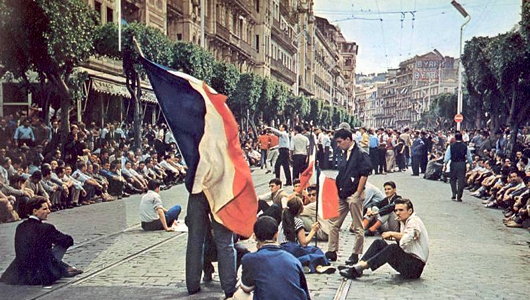
(Only interesting, I’m afraid, to those reasonably acquainted with the situation of France in May 1958)
• The French-Algerian instigators of the military rebellion led by Salan didn’t know what to make of him when he was first appointed to Algeria so they decided, just to be on the safe side, to assassinate him on his first day on the job. Salan survived the bazooka attack on his office but his ADC was killed. The general later became the only socialist freemason to lead a right-wing terror group (the OAS).
• Once the Algiers rebellion commenced and travel between Algeria and metropolitan France was cut, many supporting figures made their way across the Mediterranean by whatever means at hand. Soustelle managed to escape his police guards and get to Algiers via a secretly chartered Swiss plane, but the more romantically inclined Roger Frey — later Minister of the Interior — first tried to get to Algiers on the actor Errol Flynn’s yacht. It didn’t pan out, and instead he was forced to hire the boat of an English ex-naval officer turned smuggler.
• The man in charge of wiretapping French telephones was unsure which side would emerge on top so cautiously refrained from giving the government the full picture of the information his wiretaps revealed.
• When Corsica was seized by the rebels, Moch, the Interior Minister, decided to send in the elite of the police force, the CRS. He was afraid, however, that military transport planes would fly them directly to Algeria, so he was forced to commission Air France planes instead. Upon landing in Corsica, the entire CRS contingent was met by the rebel parachute regiment and immediately defected to the rebellion.
• So widespread was the reluctance to support the government against the military rebels that even the meteorologists send false warnings of storms in the Mediterranean in the hopes of keeping the French Navy from moving against the rebels in Algiers.
• The air force was particularly keen for de Gaulle to take power, and took to flying planes in a Cross of Lorraine formation, as well as sending troop transport planes to Algeria in case they would be needed to invade mainland France.
• Regional military commanders in France varied in their loyalty to the government and sympathy for the rebels. One commander is alleged to have told the regional prefect “M. le Préfet, I am not here to defend your préfecture, but to take it.” Other prefects warned the cabinet that any orders for the police to arrest those suspected of aiding the rebellion might result in the prefects instead being arrested themselves.
• The government had sometimes ordered firemen to unleash their water hoses against rioters in the past. As popular support for the cabinet faded away, the head of the fire brigade felt compelled to inform ministers that his men would not take part in any anti-riot measures but would merely put out any fires that erupted. “And,” he said, referring to the home of France’s National Assembly, “in the Palais Bourbon, they wouldn’t bother.”
• As Philip Williams reports in his article “How the Fourth Republic Died”:
At that night’s cabinet Pleven summed up: “We are the legal government, but what do we govern? The Minister for Algeria cannot enter Algeria. The Minister for the Sahara cannot go to the Sahara. The Minister of Information can only censor the press. The Minister of the Interior has no control over the police. The Minister of Defence is not obeyed by the army.” Said a left-wing Gaullist in the Assembly, “You are not abandoning power — it has abandoned you.”
France Marches for Marriage
Led by a provocative comedian, a gay atheist, and a socialist teacher, protest against same-sex marriage draws one million
As many as a million protesters descended upon Paris from every corner of France today to demonstrate their opposition to the Socialist government’s plans to introduce same-sex civil marriage. The Prefecture of Police estimates at least 380,000 participated in the three marches from different starting points that converged at the Champs de Mars in front of the Eiffel Tower. Organisers, however, set up counting stations and claim that, by 7:30pm tonight, over one million protestors had joined the march.
Volunteers charted more than eight hundred vehicles to bring protestors to Paris, while six TGV high-speed trains were reserved for demonstrators. “Had the conditions for chartering trains not been as stringent,” an organiser told Le Figaro “the number could easily have been double.”
“In the freezing cold,” Le Figaro reports, “young, old, and families with children were trying to keep warm waving thousands of pink flags to the jerky rhythm of techno music.”
The entire workforce of the Directorate of Public Order & Traffic was called out to handle the massive demonstration, which forced a Paris Saint-Germain football match to be brought forward. Police believed it would be impossible to secure the area around the Parc des Princes stadium when hundreds of thousands of protesters were expected in the centre of the French capital.
The protest today was organised by the eccentric comedian Frigide Barjot, founder of the Collectif pour l’humanité durable, joined by gay atheist Xavier Bongibault of the association Plus gay sans mariage (“More Gay Without Marriage”), and Laurence Tcheng of La gauche pour le mariage républicaine (“The Left for Republican Marriage”).
The unlike troika claim to have launched “a guerrilla war” against the current Socialist Party government’s proposed same-sex civil marriage legislation. Avoiding the mainstream media, ‘Team Barjot’ went direct to supporters through social media such as Facebook and Twitter, and, countering the government’s branding of same-sex civil marriage as “Mariage pour tous”, named their protest “Le Manif Pour Tous” (‘The Protest for All’), asserting that all children have a right to a mother and father.
If opinion polls are to be believed, the campaign against the proposed law seems to be changing perceptions. From 2000 to 2011, polls showed a steady rise in support for same-sex marriage. In 2012, this percentage began to decline; support for allowing same-sex couples to adopt also fell. Meanwhile, polls claim that 69% prefer same-sex marriage be put to a referendum. (more…)
‘Called Before the Tribunal of Reason’
Some Essays of Pierre Manent in English
I’VE BEEN ON a Pierre Manent kick recently, whom a friend in Paris describes as “a giant, grossly under-rated in the Anglophone world and treated with considerable disdain even in France on account of not being a prisoner of ephemeral conventional wisdom. ”
Given the current penitential season, it might be worth reading Manent’s “Reason and Faith: A Lenten Reflection”. This paragraph was one among the many that struck me with its accuracy:
Christian faith, for its part, accepts being called to appear before the tribunal of reason. It is distinctive of the Christian God to leave man to his own counsel, and to put the fulfilment of the plan of salvation as it were at the mercy of human freedom. This is why Christianity is not a law, but a faith. This is why the Bible is not a teaching dictated by heaven like the Koran. It is a chronicle, full of detours, of an often-broken and ever-renewed covenant between divine goodness and human freedom.
Much of Manent’s pondering is on the realm of political philosophy. His 1999 essay “The Return of Political Philosophy” explores the death of political philosophy over the course of the twentieth century, while his lecture “Current Problems of European Democracy” examines the depoliticisation of European societies. “The Greatness and Misery of Liberalism” is also worth a read.
A Place in Paris
With a view over the Place des Victoires
If you’re in the market for a little place in Paris, centrally located, Knight Frank has got just the thing for you. Admittedly, it’s only a wing of a larger hôtel particulier on the Rue Vide-Gousset, but it has an enviable view over the Place des Victoires. Mind you, I’ve always been of two minds about the Place des Victoires. I’m not particularly a fan of Louis XIV, whose somewhat silly equestrian statue presides foppishly over the centre of the circus: I’ve always blamed him for the French Revolution, failing to heed Margaret Mary Alacoque’s warnings and all that. But the statue’s only been there since 1828, so perhaps it can be replaced with something better in a suitably classical style. (more…)
The Architecture of Immaturity
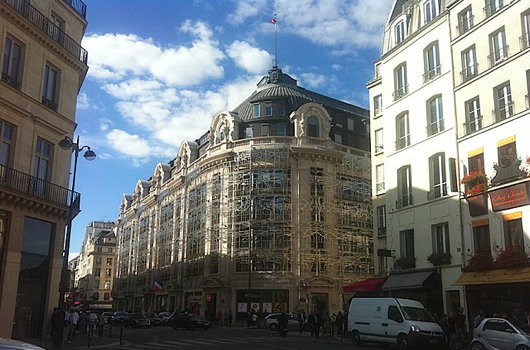
Have you ever come across the French Ministry of Culture on the Rue Saint-Honoré? It’s a perfect example of the architecture of immaturity. The government ministry was formerly strewn across nineteen different sites throughout Paris. The decision was made to consolidate their offices in one place, and the suitably central location near the Palais Royal was chosen.
The main building on the site is a handsome building from the late nineteenth-century or at the latest 1900s, with a modern 1960s office building stuck behind it. The Ministère chose architect Francis Soler to “unify” the buildings into one. At first, this was meant to be done solely through an interior reorganisation, but Soler decided to add a strange grille to the façade. (more…)
Nobility and Dignity at the Café Valois
Farewell, O good old days! Farewell, O affable visage of the proprietor and smiling and respectful reception of the waiters! Farewell, O solemn entries of the Café Valois’ dignified customs, which people were curious to see. Such was the case with the Knight Commander Odoard de La Fere’s arrival.
At exactly noon, the canon of the Palais-Royal heralded his arrival. He would appear on the threshold and pause for a moment to sweep the salon with an affable and self-assured gaze as someone eager to practice a longtime custom. His right hand pressing firmly on the white and blue porcelain handle of his cane, he threw his old faded brown cape over his shoulder with a swing of his left hand. No one ever snickered at this, since not even the most elegant mantle with golden fleur-de-lys embroidery was ever thrown back with a more distinguished movement.
In 1789 the former steward of the Prince of Conti ran the Café Valois; it was rather devoid of political colour and local flavor at that time.
Among the frequenters of the place, standing out by his noble manners, stately demeanor and wooden leg, was the Chevalier de Lautrec. He was from the second line of that family, an old brigadier of the king’s army, a Knight of Malta, of Saint Louis, of Saint Maurice and of Saint Lazare.
The Chevalier de Lautrec was a middle-aged man who lived a modest, though very dignified life on his small pension. Though he rarely appeared in society, he could be seen most often at the Palais Royal and the Café Valois. He was a very cultured mind and an assiduous reader of all the newspapers.
Deprived of his pension overnight, it was never known what the Chevalier de Lautrec lived on at a time when it was so difficult to live, and so easy to die. But here we have something that sheds at least a dim light on this mystery.
One morning after finishing a very modest breakfast in the Café Valois, as was his custom, the Chevalier de Lautrec rose from his table, chatted with all naturalness with the proprietress, who stood behind a counter, bid good-day to the master of the café with a slight gesture of the eyes, and walked out majestically saying nothing about the bill. (more…)
Turning the Book on its side
Books are a central obsession of mine. I’ve a reasonably large and ever-increasing library of my own and wherever I’ve called home there have been larger collections available to tap into: the Society Library in Manhattan, the Gericke-biblioteek in Stellenbosch, and the mostly excellent public libraries dotted around lower Westchester. When you see the wide range and styles of the book — it’s size, proportion, paper, appearance — it’s depressing to see how monotonous contemporary book publishing is today. I have a thousand different ideas on book publishing and the wide gaps in the market that are completely ignored today, but here’s one inventive idea I didn’t have.
According to Le Figaro, Editions Point Deux (a subsidiary of the La Martinière group, the third-largest publishers in France) has begun offering what it calls « le plus portables des livres » . These little books are printed on their side to be read like a flipbook rather than in the more conventional format. The idea, apparently, comes out of Holland and has proved successful in Spain, but I haven’t come across it at all in the English-speaking world.
The first question is: what’s the point? At 4.75 in. x 3.15 in., they’re a handy size, but is anything actually gained by turning the text on its side? I imagine it’d be helpful for commuters, but I think it’d be difficult to judge the concept without actually having one in hand and using it, so I think I’ll refrain from handing down a verdict just yet. Very boring of me, I know, but I’ll admit I’m intrigued by the idea.
Licorne Perdue
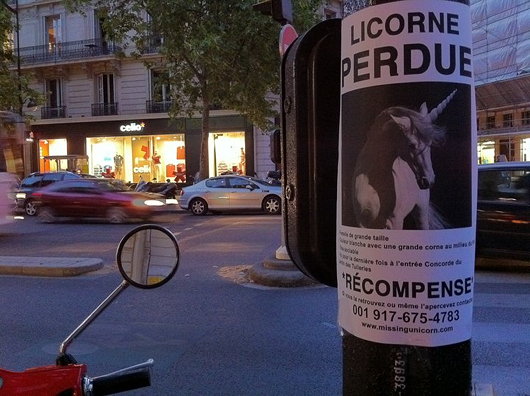
“Vu hier soir à Odéon” writes Nicholas S-M, posting this photo on Facebook.
Of course, my mind immediately wanders to Le Secret de La Licorne, the 3D film version of which (directed by Mr. Spielberg) will be released before the end of the year. I am sure I will hate it, but in that way you can hate things while still liking them.
French Flag-Fiddling
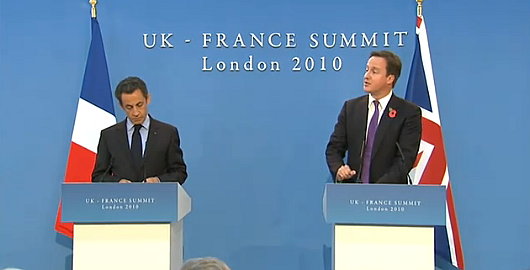
As if you needed more reasons to despise Nicolas Sarkozy! Well, this one we can’t even blame on him. Shall I explain? The national flag of France is a tricolour of three equal vertical stripes of blue, white, and red. Excepting the heady days of the Bourbon restoration, this has consistently been the French flag for the past two centuries now. A little while into the Sarkozy presidency, however, I began noticing a change only in the French flag as displayed whenever the President gave a press conference. The white stripe was reduced in width by half and the space on either side given to the neighbouring colours. The obvious deduction made was that the President wanted all three colours of the national flag shown whenever there were close-up press photographs of himself, and research confirms that this is the case. This shows an awareness for visual representation, but is nonetheless a highly unusual assault on the official flag of a nation. (more…)
Philippe Séguin
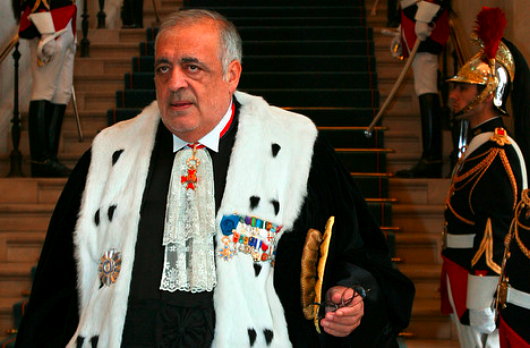
If you can possibly ignore its blood-soaked foundation and its disregard for the freedom of the Church, one can appreciate that the French Republic does republicanism with a dash of pizzazz, as evidenced by the late Philippe Séguin’s official robes as President of the Cour des comptes. Of course, most of this panache it inherited from its intermittent monarchic and (even more so) imperial past. It also inherited from Louis XIV an ever-present spirit of centralisation — the Republic frowns upon the principle of subsidiarity.
Monsieur Séguin was a decent sort. (more…)
Search
Instagram: @andcusack
Click here for my Instagram photos.Most Recent Posts
- Telephone Kiosk No. 2 May 15, 2024
- The last of its vintage May 15, 2024
- Letters Patent May 8, 2024
- Bicycle Rack April 29, 2024
- Burns Tower April 19, 2024
Most Recent Comments
Book Wishlist
Monthly Archives
Categories


